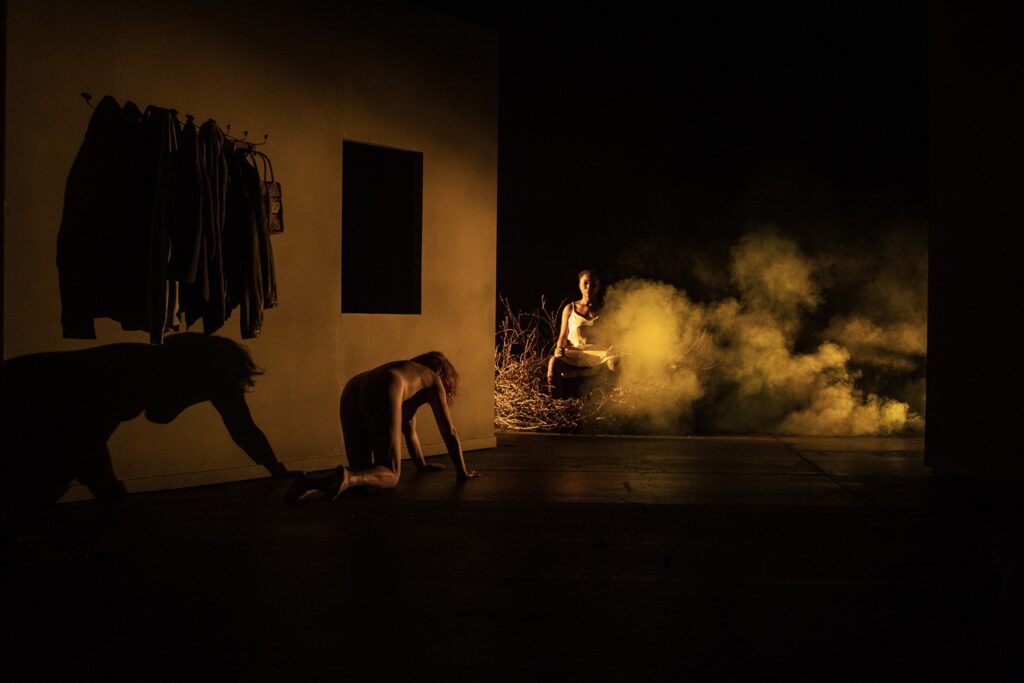National Theatre of Greece (presented as part of BITEF on 5th October 2023)
It is a dismal sight. A family hardly communicating with each other while they watch TV, talk on the phone or do the housework. They seem to be deeply absorbed in their own thoughts. Then their fragile composure is shattered. Initially it is something small, the smell of neatly folded clothes on the dresser, that causes the shift, But, then, with tears welling up, their strength leaves them, as they give themselves entirely to grief.
So begins a period of turmoil in their home. The dresser unfolds to reveal the source of their grief, the lifeless body of a young woman. The mourning process begins in earnest. Without a word, funeral rites as old as human civilisation are performed.
The death of his stepmother prompted the young director Mario Banushi to explore the topic of the end of human life at the beginning of his career. His second production, for the National Theatre in Athens, transforms the intimate experience of a personal loss into a ritual stage eschatology.
In the modestly furnished small apartment of a religious family, who keeps a large golden Orthodox icon of the Virgin Mary on their wall, we watch as the living bid farewell to the dead.
Banushi locates his concept of mourning between realism and phantasmagoria. This stylistic register develops gradually. He begins the performance with a depiction of actual Balkan ritual customs, such as sprinkling the corpse with earth, washing the deceased, dressing them for their eternal resting place, and the vigil of mourning.
Then there is a genre transition, showing the state of mind of the bereaved through the means of horror. The actors strip naked and fall into a convulsive trance reminiscent of movements reserved for exorcism scenes in Hollywood horror films. The final calming takes place through the Christian spirit. He makes his appearance by tearing open the walls of the house to reveal the wicker throne of the Madonna, on which she takes the mother of the deceased girl into her arms.
From the beginning, the audience is thrown into the home of a family about whom we know nothing. We cannot say for sure what the relationship between the people on stage is. Apart from the fact that everyone is grieving, we don’t see any other character traits. Therefore, it is very difficult to make an emotional connection to the situation to which we are suddenly introduced. Rather than relying on the effective silence of the house in mourning, which paradoxically can drown out the sound of weeping, the production utilises overly loud music and eerie noises. These only create a distance from the events on stage. The need to constantly emphasise the suffering through the accumulation of sound and visual effects creates an atmosphere that occasionally turns into forced pathos.
The people on stage are only distinguished from each other by their age and gender roles. The director clearly points to a patriarchal context. The women show their feelings openly in loud sobs, while the male character does so in subdued solitude under a blanket. While the man sleeps, the women are responsible for watching over and ritually washing the deceased. The most striking patriarchal detail is the custom in which unmarried girls are buried in wedding dress. Though Banushi consistently portrays the traditional protocol, he does not seem to have developed a stance on it.

Goodbye, Lindita – National Theatre of Greece
Certain scenes, such as the collection of excrement from a stuffed bird or the sounds of sirens and gunshots which are heard towards the end of the performance, appear suddenly and without explanation, creating an impression of confusion.
In what is only his second professional directorial effort, Banushi shows a unique sensibility and is unafraid to stage an original vision and tackle a very sensitive subject. However, his short performance, lasting just over an hour, offers no clearly defined intention. Is the play cathartic or cerebral? The sudden introduction to the tragic circumstances prevented emotional attachment, while the lack of attitude towards the patriarchal customs depicted and the unclear use of certain motifs hindered a more cerebral reception.
Despite these, however, one can undoubtedly recognise the promising talent not only of Banushi, but also of the set and costume designer Sotiris Melanos and lighting designer Tasos Palaioroutas. Their collaboration is particularly productive when it comes to creating extremely impressive and seductive scenes that are so successfully realised that they are a value in themselves.
Gently and unhurriedly, the images of a quiet family dinner, watching TV together and gazing pensively out of the window as the cigarette smoke blooms and curtains sway in the breeze, flow into one another. This is followed by an impressive image of the deceased in a traditional wedding dress with a funeral mask. The mourning turns into a devastating inner cataclysm expressed through physical disorder and auditory panic.
Banushi’s original project is an expression of a great sense of pace and imagery. With his performance, he leads the audience through the shocking landscape of his own pain and imagination, but without a clearly defined idea of where he wants to take us. Is this collection of his impressions just personal therapy or something more? Although it is not clear in this piece, it is clear, on the basis of this performance, that this director promises great things.
Credits:
Concept and direction: Mario Banushi// Dramaturg: Sophia Eftychiadou// Set and costumes: Sotiris Melanos// Music: Emmanouil Rovithis// Lighting design: Tasos Palaioroutas//Directing assistants: Afroditi Kapokaki, Theodora Patiti
Performers: Mario Banushi, Babis Galiatsatos, Alexandra Hasani, Erifyli Kitzoglou, Katerina Kristo, Helene Habia Nzanga, Vassiana Skopetea, Chryssi Vidalaki
For further information, visit: bitef.festival.rs
Andrej Čanji is a theatre critic and theatrologist based in Belgrade.








